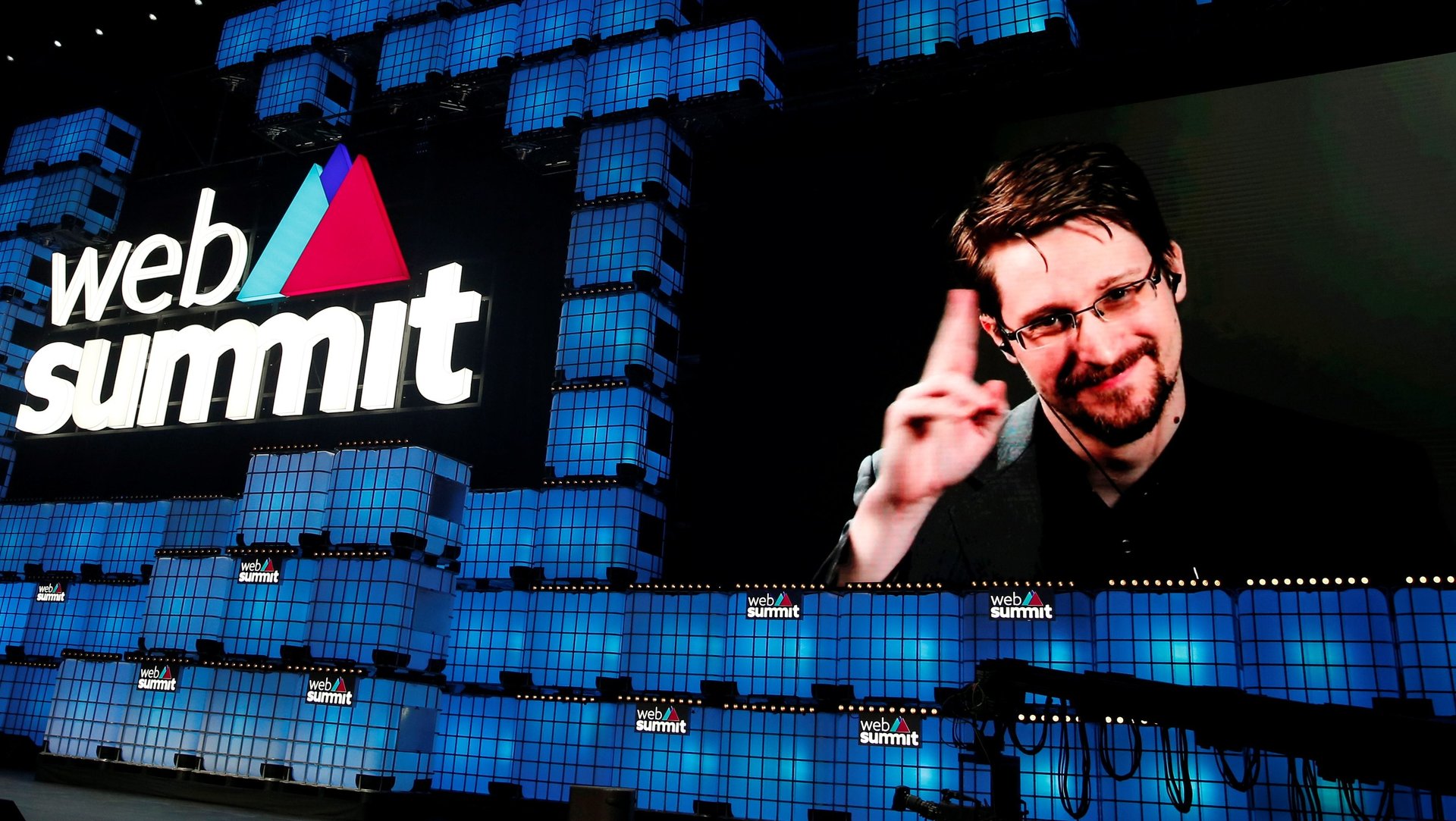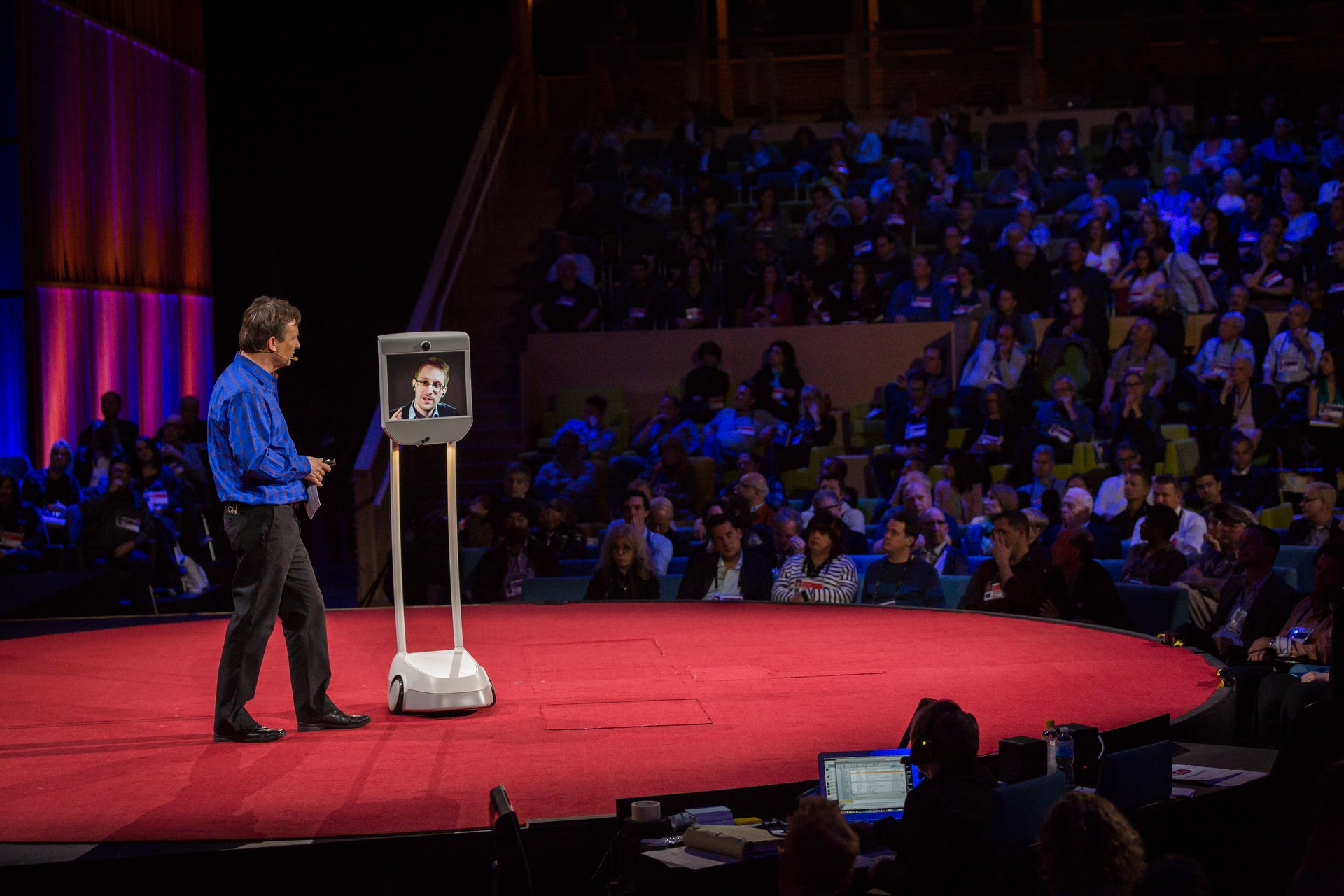Edward Snowden has mastered the art of teleconferencing
In 2014, Edward Snowden whizzed through the corridors of the Vancouver Convention Center, appearing ecstatic from a well-received surprise appearance at the TED conference. Embodied in a serviceable telepresence robot (aka the “Snowbot”), his name badge read: “Talk to me about: mass surveillance, encryption, civic duty.”


In 2014, Edward Snowden whizzed through the corridors of the Vancouver Convention Center, appearing ecstatic from a well-received surprise appearance at the TED conference. Embodied in a serviceable telepresence robot (aka the “Snowbot”), his name badge read: “Talk to me about: mass surveillance, encryption, civic duty.”
Less than a year after the US government charged him with espionage, the exiled NSA whistleblower had become the world’s most sought after virtual speaker—and one of the most skilled.
As video meetings become a fixture of our work life, the ability to give remote presentations has become an important skill. Coaches suggest looking to news anchors and talking heads for pointers, but Snowden, who’s had six years of practice dialing in remotely from his apartment in Moscow, offers a more nuanced model for DIY Zoomers.

Unlike news presenters aided by production crews, Snowden is largely a one-man show. A self-described “indoor cat,” he’s been largely sheltered in place for years by virtue of his political predicament. These days, he’s appeared on several programs to warn people about the possible dangers of tracking amid the coronavirus pandemic.

Watch any of his appearances and it’ll become apparent why Snowden is such a sought-after speaker. Since exposing the architecture of the US government’s mass spying system in 2013, he’s spoken at various gatherings—from a high school in Toronto, to an outdoor festival in Denmark, to the Web Summit in Lisbon, a massive conference attended by 70,000 people. Snowden is represented by the American Public Bureau, and organizers pay up to $25,000 to get him to appear on screen. Whether or not you agree with his politics or his tactics, watching Snowden offers a masterclass in the tone, delivery, and style of effective virtual presentations.
Speaking in clear, measured language, Snowden sticks to his point and tailors his remarks to his audience. To techies at SXSW, for instance, he said, “It’s the development community who can really craft those solutions to make sure we’re safe. The NSA…they’re setting fire to the future of the internet. The people in this room now, you guys are the firefighters.”
Appealing to TED’s influential optimists he suggested: “We need to encode our values not just in writing, but in the structure of the Internet, and it’s something that I hope, I invite everyone in the audience, not just here in Vancouver but around the world, to join and participate in.” And he stoked the anti-Facebook fervor at Paris’s Sorbonne University in 2018, saying: “Facebook is a surveillance company, and their product is you.” In this instance, he carefully articulates each word and speaks at a pace that his translator can manage.
For an IT guy, Snowden is especially compelling, defying the dreaded monotone that plagues many technical speakers. He varies the cadence of his sentences to keep listeners engaged and will, on occasion, even insert a joke. He once advised John Oliver on choosing stronger passwords: “The best advice here is to shift your thinking from password to passphrase. Think about a common phrase that works for you, that’s too long to brute force and also too long to be in a dictionary…like margaretthatcheris100%SEXY.”
Telepresence robots are the exception—Snowden usually appears before a clean, grey background, eschewing the tired bookshelf trope of many at-home presenters use. The plain backdrop focuses attention on the speaker and, in Snowden’s case, conceals any location cues that may tip interested parties to his exact whereabouts. His at-home studio set-up is briefly shown in the closing segments of the documentary, “Meeting Edward Snowden.”
Snowden’s shirts are also plain, often matching the color of his backdrop, which has the effect of eliminating visual distractions on the screen. Using Google Hangouts or the more secure platform called Jitsi for public appearances, his video and audio are somehow consistently crisp. Snowden looks into the camera, which psychologists say, improves one’s trustworthiness.
There are other notable virtual conference speakers who deploy more sophisticated technology. Among them is Audrey Tang, Taiwan’s captivating digital minister, who at times appears at international conferences as a hologram. There’s avatar artist LaTurbo Avedon who delivers talks as a CGI figure. At Barcelona’s IAM Weekend, she once gave a speech so affecting that it moved some audience members to tears, organizers tell Quartz. Then there’s Bina 48, an AI-powered humanoid robot who serves as a surrogate for biotech entrepreneur Bina Rothblatt. For the C2 Conference in Montreal, Bina is billeted as “a black, female-presenting advanced social robot and ambassador for the multi-decade mind uploading experiment in AI and cyber-consciousness.”
But Snowden offers the most relatable example for teleworkers everywhere. And his story contains some encouraging news for nervous speakers. Though he appears articulate and composed, Snowden says this acuity was honed through practice. In his autobiography, Permanent Record, he confesses feeling insecure in front of the camera. His account of the weeklong shoot with director Laura Poitras even oddly echoes common feelings about virtual meetings: “Nothing could have prepared me for the moment when she pointed her camera at me, sprawled out on my unmade bed in a cramped, messy room that I hadn’t left for the past ten days,” Snowden writes.
“Though today nearly all of my interactions take place via camera, I’m still not sure which experience I find more alienating: seeing myself on film or being filmed. I try to avoid the former, but avoiding the latter is now difficult for everyone.”